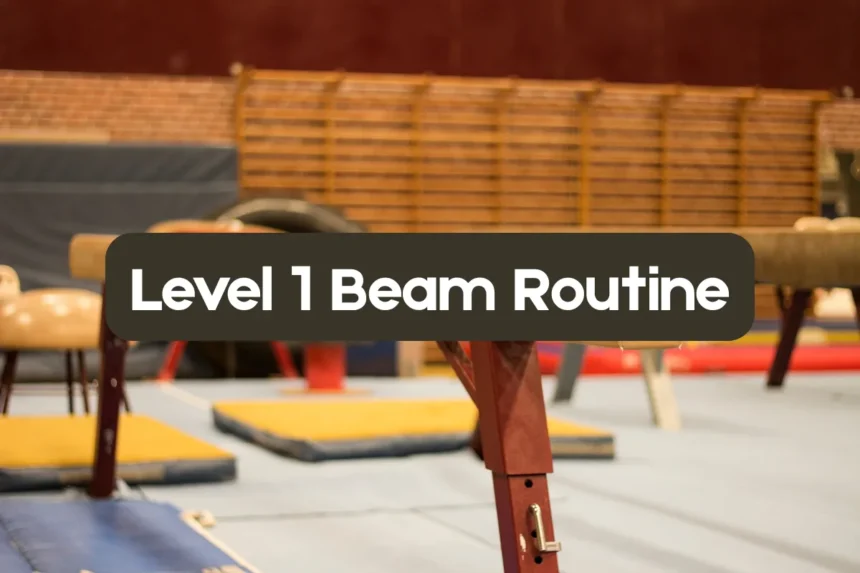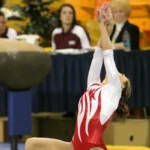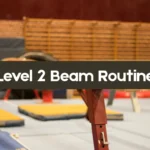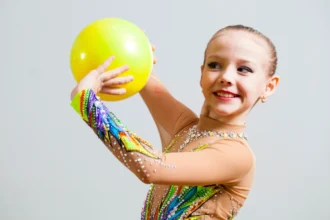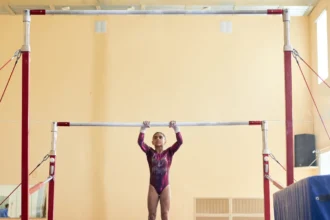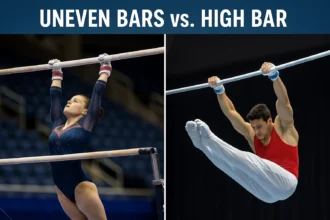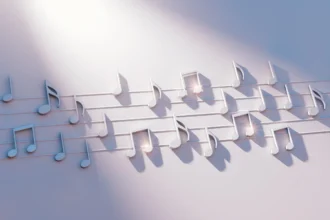Beam routines are key elements in artistic gymnastics competitions. Each level from 1 to 5 has specific requirements for the skills gymnasts need to perform.
If Level 1 floor teaches gymnasts to “dance with the ground,” then the Level 1 beam routine is their first real conversation with height. The beam may only stand 1.25 meters above the mat, but for a 6- or 7-year-old, it can feel like a skyscraper.
The Level 1 beam routine introduces young gymnasts to performing confidently on a narrow surface. With mounts, balances, and a side handstand dismount, this routine builds the basics every gymnast needs.
Mount and Starting Shape
The routine begins with a salute at the end of the beam.
To mount the beam, the gymnast jumps to a front support near one end. The dominant leg swings over the beam, and the gymnast turns into a straddle sit. Legs stay tight and straight. The arms lift to a crown, then return down behind the body.
Next comes a tuck. Both legs bend together, and then the dominant leg lifts. This takes the gymnast into a tuck sit with arms overhead in crown. From there, the gymnast steps one foot down flat and leans forward into a lever. The hips must stay square to the beam, not turned outward.
After the lever, the gymnast returns to a tuck squat with arms in crown, then stands tall on relevé to continue.
Balance Poses and Stretch Jump
From the relevé, the gymnast places both hands on their hips. The dominant leg steps forward flat onto the beam. Then, the non-dominant leg lifts into a passé. The knee should be level with the hip and the toe pointed beside the knee, not behind it.
From passé, the leg lowers behind into a clean pose position. This leads into the stretch jump.
Arms lift straight up and the gymnast performs a jump in place with toes pointed. The arms stay in crown during the jump and the landing. After landing, the gymnast rises into another crown on relevé.
Then comes a tap arabesque. Arms move to a T shape as the dominant leg steps down and the non-dominant leg lifts straight behind. Hold the arabesque momentarily, then tap the foot down.
Leg Swings and Lock Stand
Now the gymnast practices future leap motions through leg swings. From the arabesque tap, step forward with the non-dominant leg and swing the dominant leg in front. Set it down and swing the non-dominant leg next. Step onto that leg, place the dominant foot in front again, and finish in a lock stand.
A lock means both feet stay close together, one slightly behind the other, with the dominant foot in front. Arms lift high during the lock.
Arm Poses Before the Dismount
Before dismounting, the gymnast performs three choreographed arm movements.
First, they step back with the dominant foot and drop the front heel into a forced arch. While doing this, they bend the arms softly and push forward with the wrists. That’s the “supple push.”
Then they step back again and interlock their fingers. Arms straighten forward in a strong pull. The gymnast finishes by pointing the dominant foot forward, raising both arms overhead, and kneeling down in preparation for the dismount.
Side Handstand Dismount
The dismount begins from a kneeling position on the beam, with the dominant leg forward.
The gymnast reaches down, places their hands on the beam, and kicks into a side handstand. This is a controlled handstand with legs stacked and tight. The gymnast then falls sideways off the beam to land on the mat.
After landing, they salute to finish.
Bottom line
Level 1 beam is about control, clean lines, and learning how to move with confidence on a narrow surface. The shapes in this routine will come back again and again in higher levels.
Practicing each piece slowly helps gymnasts build great habits from the start. Once each section feels comfortable, they can work on smooth transitions and performance.


